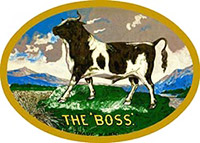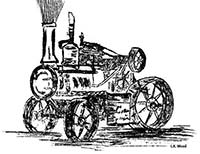
Russell Company's Ghost
Perhaps there is no greater sentimental admirer of the Russell Company's threshing machinery than myself. This fondness goes back to my earliest recollection. The Russell ten horsepower engine stood in a shed in the back part of Richards' lot. Mother took her twin boys to the quilting with her. My curiosity was aroused by the black monster with its shiny brass parts and touches of
I had heard the folks comment on the recent purchase of the ingenious invention they knew nothing about and even criticism was common in the house, of such a wild adventure, of going in debt a thousand dollars which was a vast figure in the early nineties.
My fondness grew for Old Betsy,
as the engine was christened, after a famous pulling horse belonging to an early settler. No opportunities were lost in being near the idol of my youth, whether the Russell was at work threshing or parked for the long winter months, spring and summer, and I longed for late August or September to come when she would be resuscitated and do her task. As soon as I was able to decipher the enchanting words of Russell and Company, Builders, Massillon, Ohio, on the smoke box door, I longed some day to visit that far off place and the great plant.

School days were spiced with some catalogs I had sent for. The teacher allowed me to draw "Old Betsy," on the black board. It took most of the winter. At recess I stole away to A.W. Richards' barn where she was housed for the winter, hardly making it back before the bell rang, sometimes coming in with a smear of grease on my hands.
While assigned the task of herding cows on the foothills, canyons and dell, when I saw the smoke from "Old Betsy," without resisting I was scampering over the stubble with bare feet to be by her side. As years rolled by and the little Russell ten and Massillon Cyclone separator made their regular runs, I sought a job on it, even stacking straw just to be near, smell and hear her throbbing and puffing.

The real opportunity to visit the factory and realize my dreams did not come until 1939, the year of the World Fair in New York City. Accepting the invitation of Dave Elman on the Hobby Lobby program, I packed my little one-ninth scale Russell model I had made and started for the fair. My main object was to visit the fairyland of my childhood, Massillon, Ohio. I stopped over at Cleveland, Ohio, and next day boarded the bus for Massillon. Familiar places where years ago were such thriving companies as C. Aultman and A.D. Baker, were passed thru on the route. But when the name Massillon, five miles, appeared on a road sign, how my heart throbbed with joy. Could it be true, was I nearing the goal of my dreams? I watched closely for Erie Street and asked to get off. Then I found myself confronting the old office building, moss covering and stones crumbling. As I opened the heavy door, hung on strap hinges which squeaked as if shrieking from a long passed industrial day, Mr. Henry Snyder greeted me and relieved me of my precious luggage after my introducing myself.
A cordial welcome was extended. The contents of the green box were lifted out and placed on the table. He was admiring its close resemblance of the prototype. I had copied the serial number on "Old Betsy," and others of the same vintage. A large book with blue cover was taken off the mantle, dust was blown off and Mr. Snyder turned to the record of the most famous engine, number 6672, built January 23rd 1892, assigned to Salt Lake City, Utah, May 9th, 1892, etc.

I asked to visit the plant. As we entered the separator erecting room, two lone men were at work on the latest steel frame Russell separator. The next room was the old paint room. Smears of
Our last but not least was the pattern dock. As we ascended the wide rickety stair, I almost felt the presence of the Russell Brothers. I caught sight of the patterns of Giddings' patent clutch and his double-ported valve. It seemed he too, was with us. Patterns of the Duigee Woodbury Horsepower also brought Mr. Duigee in our midst. The various intricate patterns for the separator, engines and other Russell products all looked so familiar, as I had so often encountered in the far off Rockies.
The day had been too short. I felt a spirit of awe as I left the old plant and boarded my bus to resume my journey. Thoughts were mingled with sublimity as I watched the vast crowds of Massillon, mostly of the third generation, wondering if they ever heard of the once household word Russell, among the founders of a great commonwealth and the main industry of their city, employing over eight-hundred men. The shrines to the memory of Charles M. Russell and his brother are known today by few. Thus I left behind the realization of my childhood dreams— The Ghost of Russell and Company.1
Notes…
L.K. Wood found "Old Betsy," a worn out hulk of a boiler on wheels, and restored her to her former glory. Of all the steam traction engines he owned, this is the one he loved the very most.
He built a half scale version as well as the one-ninth scale model noted here. This was the first steam engine to come to Cache Valley and early Mendon, Utah at the great expense at the time, of one thousand dollars. Today "Old Betsy," resides at the U.S.U. Jensen Historical Farm, near Wellsville, Utah.
Unloved and rusting away in a state of disrepair, "Old Betsy," it would seem, will never make steam again. L.K. Wood's dream of keeping steam alive in Cache Valley has fallen to the wayside, and his work, the separators and horsepower traps, the model's he built with such care, are dusty and stored in a old back shed. Most of the people there don't even know they house them.
- Russell Company's Ghost, L.K. Wood.